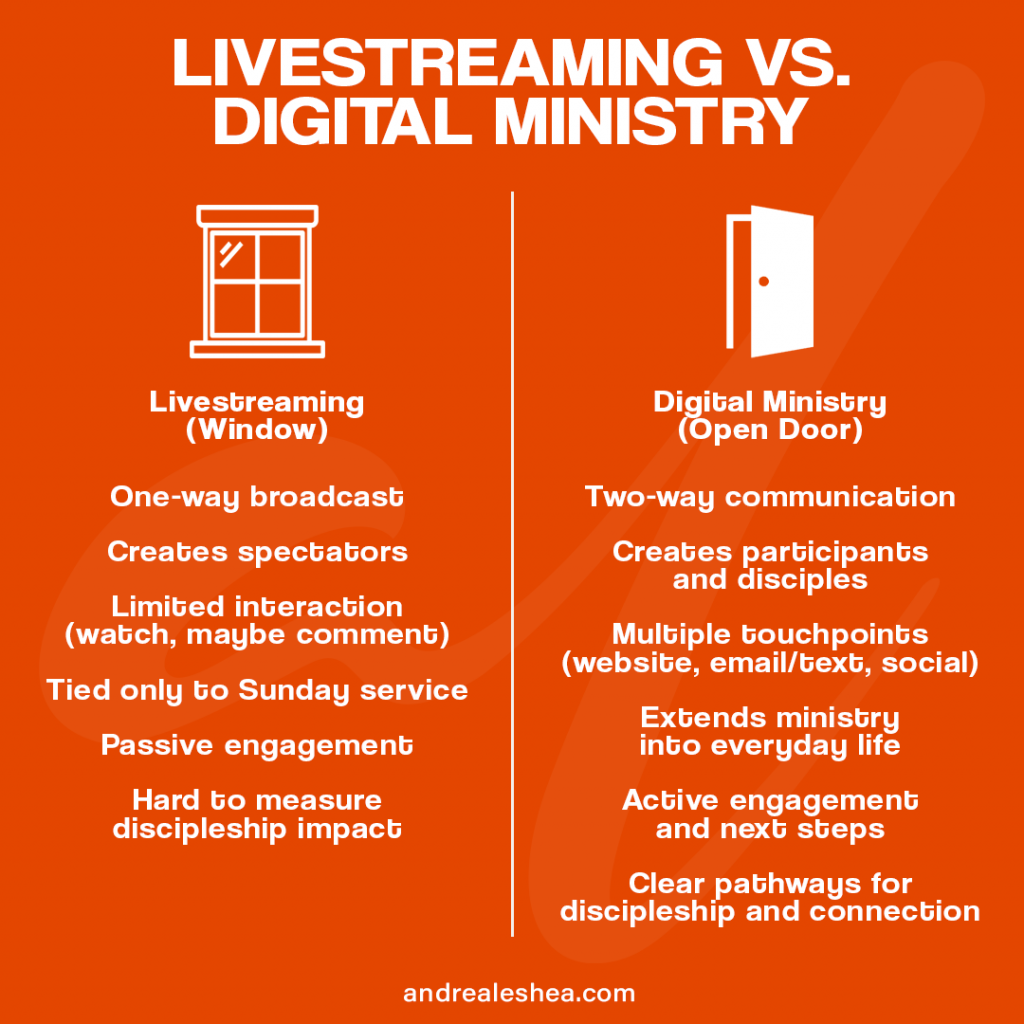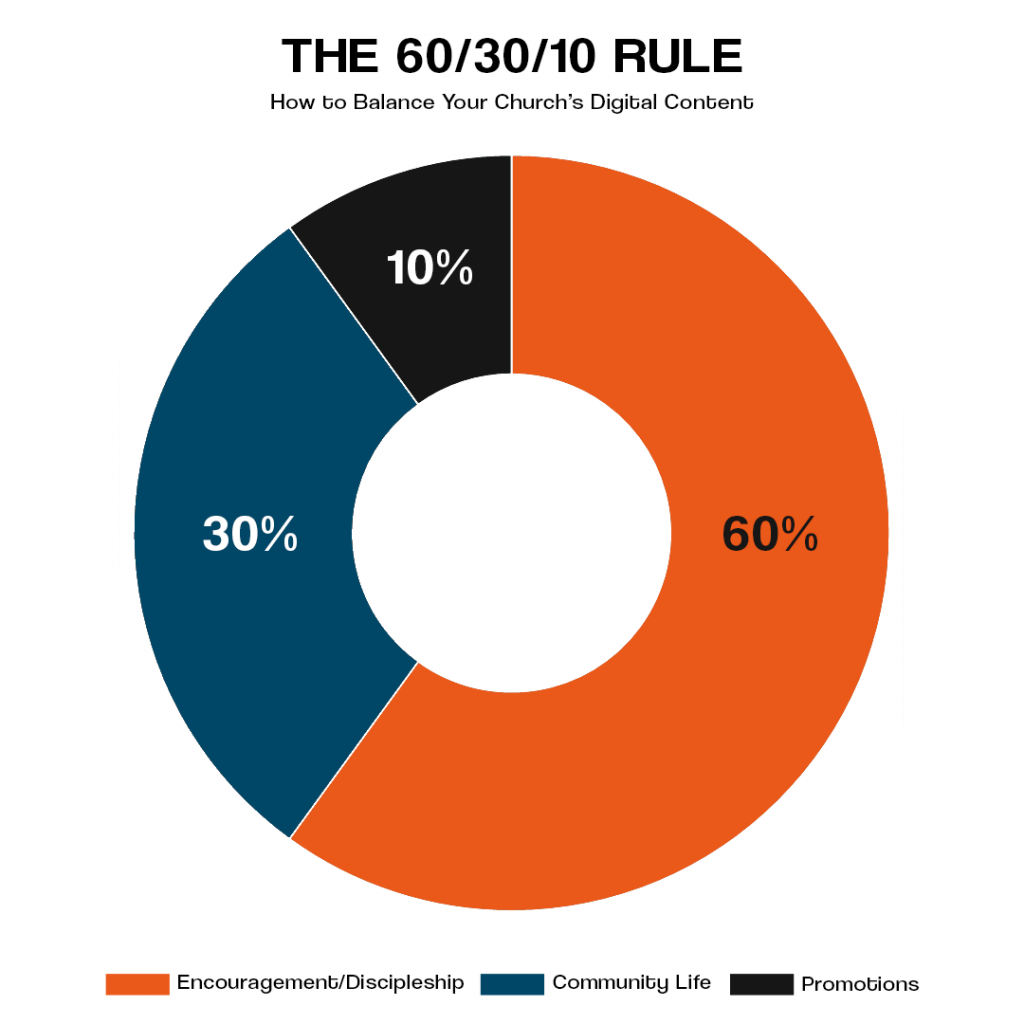In 2025, digital isn’t optional. It’s a mission field. The Great Commission calls us to go out into the world, and technology gives us an unprecedented way to do that every single day. Digital platforms allow the church to carry the gospel into homes, workplaces, and communities far beyond our physical walls. People in your community are searching for hope online long before they consider walking into your building. In fact, studies show that one-third of churchgoers first discovered their church online. That means your church’s digital presence is not just marketing. It’s ministry.
Digital Ministry Is More Than Livestreaming
Too many churches think “digital” just means livestreaming the Sunday service. While livestream has value, it often functions like a closed window. People can peek inside, but they can’t come closer. It creates spectators, not disciples.
Digital done right is an open door inviting people to engage, be discipled, and experience your church even if they never step inside. The goal isn’t just to fill seats; it’s to grow the Kingdom.
That requires a mindset shift:
- From Spectators → Participants: Don’t just broadcast. Invite people to comment on posts, submit prayer requests through your website, and respond to guest follow-up emails. Participation creates belonging before attendance.
- From Promotion → Connection: Endless event ads won’t keep people’s attention. Connection happens when you share testimonies on your site, encouragement through text updates, and authentic conversations on social media.
- From Add-On → Extension: Digital can’t be a side project. It must extend your mission into homes, schools, workplaces, and the lives of people who may never step inside your building. Every digital touchpoint should help someone take a next step.

So how do you put these shifts into practice? It starts with three non-negotiable tools that growing churches are using right now to turn digital into a true ministry field.
Tool 1: A Clear, Updated Website (Your Digital Front Door)
Most people will visit your website before they visit your church. If they can’t quickly find when and where you meet, what you’re about, and how to connect, they’ll move on. A clear, updated website builds confidence for guests, anchors all other communication, and gives members easy access to what they need. This is why your website isn’t optional. It’s your digital front door.
How to apply this:
- Test your homepage: can someone find service times and location in under 10 seconds?
- Add a “Plan Your Visit” button with details for guests (parking, kids, what to expect).
- Update photos at least once a quarter so the site reflects real church life, not stock images.
- Include a Next Steps page that makes it simple for people to join a group, volunteer, or give.
Tool 2: Email/Text Communication (Your Direct Line)
Social media is rented land, and you don’t own the algorithm. But you do own your email and text lists. These are the most reliable ways to connect directly with people, whether following up with guests or discipling members during the week. Done well, email and text communication keep guests from falling through the cracks, build trust with members, and provide consistent discipleship touchpoints.
How to apply this:
- Collect emails/mobile numbers every Sunday with a simple connection card (digital or paper).
- Create a basic guest follow-up sequence: Day 1: Thank them, Day 3: Share about groups/kids, Day 7: Personal invite from the pastor.
- Send one weekly church-wide update that is short, clear, and focused on one main action.
- Add personalization. One personal message from a pastor or leader often goes further than ten general announcements.
Tool 3: A Social Media Presence (Your Digital Word of Mouth)
Guests often check your social media to see the “life” of your church. If your pages are inactive or outdated, they’ll assume your church is too. On the other hand, an active, authentic presence extends Sunday into the week, gives members an easy way to invite friends, and places your church in the digital spaces where people are already spending time. Surveys show that 72% of people in America use some form of social media daily, which means showing up online gives your church wide reach potential.
How to apply this:
- Pick 2 posting rhythms: Stories for real-time moments, Posts/Reels for weekly highlights.
- Use the 60/30/10 rule: 60% encouragement/discipleship, 30% community life, 10% promotions.
- Train a few volunteers to snap pictures of authentic moments every week (kids, worship, serving).
- Start small. Even one consistent weekly post beats random bursts of activity.

Conclusion: Digital Is Ministry
Digital is not a distraction from real ministry. It is ministry. When you steward these three tools with consistency and purpose, you extend your church’s reach, disciple people throughout the week, and serve those who may never step inside your building.
Embracing digital means more than just keeping up with technology. You’re stepping into the mission field God has already opened before you. The opportunity is right in front of you. The question is, will you use it?





